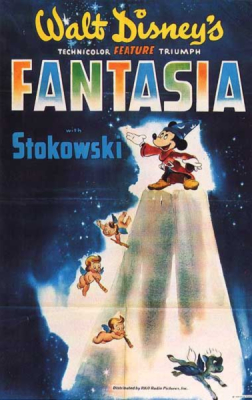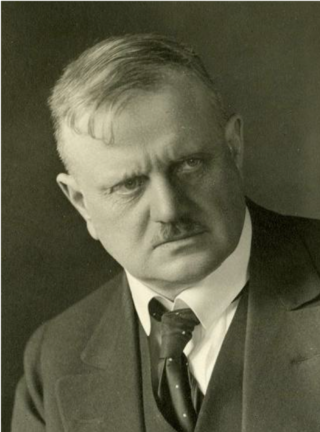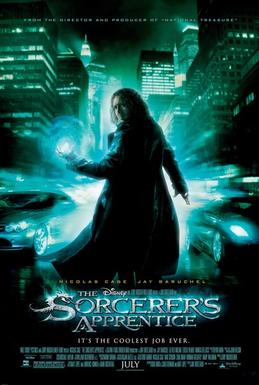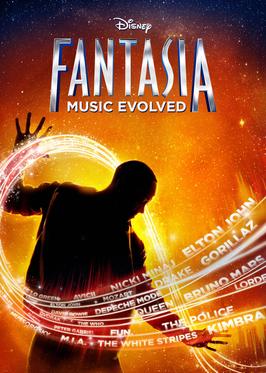
Fantasia is a 1940 American animated musical anthology film produced by Walt Disney Productions, with story direction by Joe Grant and Dick Huemer and production supervision by Walt Disney and Ben Sharpsteen. It consists of eight animated segments set to pieces of classical music conducted by Leopold Stokowski, seven of which are performed by the Philadelphia Orchestra. Music critic and composer Deems Taylor acts as the film's Master of Ceremonies who introduces each segment in live action.

Paul Abraham Dukas was a French composer, critic, scholar and teacher. A studious man of retiring personality, he was intensely self-critical, having abandoned and destroyed many of his compositions. His best-known work is the orchestral piece The Sorcerer's Apprentice, the fame of which has eclipsed that of his other surviving works. Among these are the opera Ariane et Barbe-bleue, his Symphony in C and Piano Sonata in E-flat minor, the Variations, Interlude and Finale on a Theme by Rameau, and a ballet, La Péri.
A symphonic poem or tone poem is a piece of orchestral music, usually in a single continuous movement, which illustrates or evokes the content of a poem, short story, novel, painting, landscape, or other (non-musical) source. The German term Tondichtung appears to have been first used by the composer Carl Loewe in 1828. The Hungarian composer Franz Liszt first applied the term Symphonische Dichtung to his 13 works in this vein.

Leopold Anthony Stokowski was a British-American conductor. One of the leading conductors of the early and mid-20th century, he is best known for his long association with the Philadelphia Orchestra. He was especially noted for his free-hand conducting style that spurned the traditional baton and for obtaining a characteristically sumptuous sound from the orchestras he directed.
Program music or programmatic music is a type of instrumental art music that attempts to musically render an extramusical narrative. The narrative itself might be offered to the audience through the piece's title, or in the form of program notes, inviting imaginative correlations with the music. A well-known example is Sergei Prokofiev's Peter and the Wolf.
Oskar Wilhelm Fischinger was a German-American abstract animator, filmmaker, and painter, notable for creating abstract musical animation many decades before the appearance of computer graphics and music videos. He created special effects for Fritz Lang's 1929 Woman in the Moon, one of the first sci-fi rocket films, and influenced Disney's Fantasia. He made over 50 short films and painted around 800 canvases, many of which are in museums, galleries, and collections worldwide. Among his film works is Motion Painting No. 1 (1947), which is now listed on the National Film Registry of the U.S. Library of Congress.
Fantasound was a sound reproduction system developed by engineers of Walt Disney studios and RCA for Walt Disney's animated film Fantasia, the first commercial film released in stereo.

Fantasia 2000 is a 1999 American animated musical anthology film produced by Walt Disney Feature Animation and released by Walt Disney Pictures. Produced by Roy E. Disney and Donald W. Ernst, it is the sequel to Disney's 1940 animated feature film Fantasia. Like its predecessor, Fantasia 2000 consists of animated segments set to pieces of classical music. Celebrities including Steve Martin, Itzhak Perlman, Quincy Jones, Bette Midler, James Earl Jones, Penn & Teller, James Levine, and Angela Lansbury introduce a segment in live action scenes directed by Don Hahn.

"The Sorcerer's Apprentice" is a poem by Johann Wolfgang von Goethe written in 1797. The poem is a ballad in 14 stanzas.
Suite bergamasque is a piano suite by Claude Debussy. He began composing it around 1890, at the age of 28, but significantly revised it just before its 1905 publication. The popularity of the third movement, Clair de lune, has made it one of the composer's most famous works for piano, as well as one of the most famous musical pieces of all time.

La mer, trois esquisses symphoniques pour orchestre, or simply La mer, L. 109, CD. 111, is an orchestral composition by the French composer Claude Debussy.

The Oceanides, Op. 73, is a single-movement tone poem for orchestra written from 1913 to 1914 by the Finnish composer Jean Sibelius. The piece, which refers to the nymphs in Greek mythology who inhabited the Mediterranean Sea, premiered on 4 June 1914 at the Norfolk Music Festival in Connecticut with Sibelius conducting. Praised upon its premiere as "the finest evocation of the sea ... ever ... produced in music", the tone poem, in D major, consists of two subjects, said to represent the playful activity of the nymphs and the majesty of the ocean, respectively. Sibelius gradually develops this material over three informal stages: first, a placid ocean; second, a gathering storm; and third, a thunderous wave-crash climax. As the tempest subsides, a final chord sounds, symbolizing the mighty power and limitless expanse of the sea.

The Sorcerer's Apprentice is a 2010 American action adventure fantasy film produced by Jerry Bruckheimer, directed by Jon Turteltaub, and released by Walt Disney Pictures, the team behind the National Treasure franchise. The film stars Nicolas Cage and Jay Baruchel with Alfred Molina, Teresa Palmer, and Monica Bellucci in supporting roles.
Sorcerer's Apprentice may refer to:
The Symphonic Variations, M. 46, is a work for piano and orchestra written in 1885 by César Franck. It has been described as "one of Franck's tightest and most finished works", "a superb blending of piano and orchestra", and "a flawless work and as near perfection as a human composer can hope to get in a work of this nature". It is a fine example of Franck's use of cyclic unity, with one theme growing into various others. The piano and orchestra share equally in the development of ideas. The work is in F♯ minor. Duration in performance is about fifteen minutes, and the instrumentation is piano solo and orchestra: pairs of flutes, oboes, clarinets, and bassoons; four horns; two trumpets; timpani; and strings.

Fantasia: Music Evolved is a 2014 motion-controlled music rhythm game developed by Harmonix for the Xbox 360 and Xbox One with Kinect. The game is the interactive successor to Walt Disney's 1940 animated film Fantasia and its 1999 sequel Fantasia 2000, both of which it is based upon.

Fantasia is an American media franchise owned by The Walt Disney Company that commenced in 1940 with the theatrical release of the film of the same name.
The Second Concerto for Orchestra is a concerto for orchestra by the American composer Steven Stucky. The work was commissioned by the Los Angeles Philharmonic while Stucky was their composer-in-residence for the inaugural season of the Walt Disney Concert Hall. It was completed in 2003 and was first performed on March 12, 2004, with the conductor Esa-Pekka Salonen leading the Los Angeles Philharmonic. The piece was awarded the 2005 Pulitzer Prize for Music.

Fantasia 2000: An Original Walt Disney Records Soundtrack is the soundtrack to Fantasia 2000, a sequel to the animated anthology film Fantasia (1940). It features eight individual score suites for each segment and were named after the same title of these segments that are set to pieces of classical music. The film went through several development section, after the success of the 1990 re-issue and home-video sales of Fantasia. James Levine conducted six of the tracks from the film, which are performed by the Chicago Symphony Orchestra, while the rest of the two tracks: especially one for The Sorcerer's Apperentice segment reused music from the 1940 film, while the score for Rhapsody in Blue was originally conducted by Bruce Boughton for the film, while Levine conducted for the soundtrack. The track was performed by the Philharmonia Orchestra. The album released on November 30, 1999, by Walt Disney Records and Sony Classical Records, went on to reach the number one spot on the Billboard Top Classical Albums chart in July 2000.












